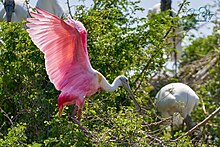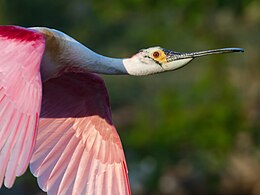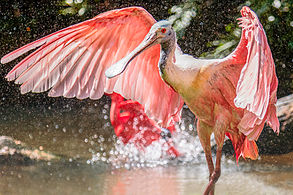Roseate spoonbill
| Roseate spoonbill Temporal range:
| |
|---|---|

| |
| In the Catazajá, Chiapas | |
| Scientific classification | |
| Kingdom: | Animalia |
| Phylum: | Chordata |
| Class: | Aves |
| Order: | Pelecaniformes |
| Family: | Threskiornithidae |
| Genus: | Platalea |
| Species: | P. ajaja
|
| Binomial name | |
| Platalea ajaja | |

| |
| Synonyms | |
|
Ajaia ajaja (Linnaeus, 1758) | |
The roseate spoonbill (Platalea ajaja) is a gregarious wading bird of the ibis and spoonbill family, Threskiornithidae. It is a resident breeder in both South and North America.
Taxonomy[]
The roseate spoonbill is sometimes placed in its own genus - Ajaja. A 2010 study of mitochondrial DNA of the spoonbills by Chesser and colleagues found that the roseate and yellow-billed spoonbills were each other's closest relatives, and the two were descended from an early offshoot from the ancestors of the other four spoonbill species. They felt the genetic evidence meant it was equally valid to consider all six to be classified within the genus Platalea or alternatively the two placed in the monotypic genera Platibis and Ajaja, respectively. However, as the six species were so similar morphologically, keeping them within the one genus made more sense.[2]
Description[]
The roseate spoonbill is 71–86 cm (28–34 in) long, with a 120–133 cm (47–52 in) wingspan and a body mass of 1.2–1.8 kg (2.6–4.0 lb).[3] The tarsus measures 9.7–12.4 cm (3.8–4.9 in), the culmen measures 14.5–18 cm (5.7–7.1 in) and the wing measures 32.3–37.5 cm (12.7–14.8 in) and thus the legs, bill, neck and spatulate bill all appear elongated.[4] Adults have a bare greenish head ("golden buff" when breeding[5]) and a white neck, back and breast (with a tuft of pink feathers in the center when breeding), and are otherwise a deep pink. The bill is grey. There is no significant sexual dimorphism.
Like the American flamingo, their pink color is diet-derived, consisting of the carotenoid pigment canthaxanthin. Another carotenoid, astaxanthin, can also be found deposited in flight and body feathers.[6] The colors can range from pale pink to bright magenta, depending on age, whether breeding or not, and location. Unlike herons, spoonbills fly with their necks outstretched. They alternate groups of stiff, shallow wingbeats with glides.[7]
Distribution[]
The species occurs in South America mostly east of the Andes, and in coastal regions of the Caribbean, Central America, Mexico, and the Gulf Coast of the United States,[8][9] and from central Florida's Atlantic coast[10] at Merritt Island National Wildlife Refuge, adjoined with NASA Kennedy Space Center at least as far north as South Carolina's Myrtle Beach.[11] In the summer of 2021, sightings of the bird were reported well outside its typical range, including in Washington, D.C., upstate New York, and even New Hampshire.[12]
Behavior[]
This species feeds in shallow fresh or coastal waters by swinging its bill from side to side as it steadily walks through the water, often in groups. The spoon-shaped bill allows it to sift easily through mud. It feeds on crustaceans, aquatic insects, frogs, newts and very small fish ignored by larger waders. In the United States, a popular place to observe roseate spoonbills is "Ding" Darling National Wildlife Refuge in Florida. Roseate spoonbills must compete for food with snowy egrets, great egrets, tricolored herons and American white pelicans.

On High Island, Texas, United States

At GaiaZoo, Netherlands

Foraging roseate spoonbills at Merritt Island, Florida United States
Video of feeding behavior, Merritt Island, Florida United States

Roseate spoonbill at Sian Ka'an Biosphere Reserve, Mexico
Breeding[]
The roseate spoonbill nests in shrubs or trees, often mangroves, laying two to five eggs, which are whitish with brown markings.[7] Immature birds have white, feathered heads, and the pink of the plumage is paler. The bill is yellowish or pinkish.

Adult with two juveniles on a nest
Conservation and threats[]
Information about predation on adults is lacking. Nestlings are sometimes killed by turkey vultures, bald eagles, raccoons and fire ants.[9] In 2006, a 16-year-old banded bird was discovered, making it the oldest known wild individual.[13]
References[]
- ^ BirdLife International (2016). "Platalea ajaja". IUCN Red List of Threatened Species. 2016: e.T22697574A93621961. doi:10.2305/IUCN.UK.2016-3.RLTS.T22697574A93621961.en. Retrieved 19 November 2021.
- ^ Chesser, R.Terry; Yeung, Carol K.L.; Yao, Cheng-Te; Tians, Xiu-Hua; Li Shou-Hsien (2010). "Molecular phylogeny of the spoonbills (Aves: Threskiornithidae) based on mitochondrial DNA". Zootaxa. 2603 (2603): 53–60. doi:10.11646/zootaxa.2603.1.2. ISSN 1175-5326.
- ^ "Roseate Spoonbill Life History, All About Birds, Cornell Lab of Ornithology". www.allaboutbirds.org.
- ^ Hancock, Kushlan & Kahl (1992). Storks, Ibises, and Spoonbills of the World. Academic Press. ISBN 978-0-12-322730-0.
- ^ Howell, SNG; Webb, S (1995). A Guide to the Birds of Mexico and Northern Central America. Oxford University Press. pp. 147–8. ISBN 978-0-19-854012-0.
- ^ Brush, A. H. 1990. Metabolism of cartenoid pigments in birds. The FASEB Journal. 4:2969-2977.
Fox, D. L. 1962. Carotenoids of the Roseate Spoonbill. Comparative Biochemistry and Physiology 6:305-310.
(Mentioned in the Cornell Lab of Ornithology page). - ^ a b Howell, SNG; Webb, S (1995). A Guide to the Birds of Mexico and Northern Central America. Oxford University Press. pp. 147–8. ISBN 978-0-19-854012-0.
- ^ "Roseate Spoonbill". Waterbird Conservation. National Audubon Society. Archived from the original on 2008-10-24. Retrieved 2009-07-23.
- ^ a b Dumas, Jeannette V. 2000. Roseate Spoonbill (Platalea ajaja), The Birds of North America Online (A. Poole, Ed.). Ithaca: Cornell Lab of Ornithology. Retrieved 2009-11-12. (subscription required)
- ^ Graham Jr., Frank (July–August 2001). "Birds: A Wing and a Prayer". Audubon Magazine: 87–91.
- ^ Quinn, Joe. "Huntington Beach State Park in Murrells Inlet, South Carolina: White Heron, Roseate Spoonbill, American Alligator". Smithsonian Magazine.
- ^ "Tropical Pink Bird Spotted In D.C. For The First Time (It's Not A Flamingo)". DCist. Retrieved 2021-08-04.
- ^ "Researchers: Oldest Wild Spoonbill Found - Care2 News Network". Care2.com. 2006-05-29. Retrieved 2012-02-20.
External links[]
| Wikimedia Commons has media related to Roseate spoonbill. |
| Wikispecies has information related to Platalea ajaja. |
- Field guide on Flickr
- "Roseate spoonbill media". Internet Bird Collection.
- Roseate spoonbill photo gallery at VIREO (Drexel University)
- Roseate spoonbill species account at Neotropical Birds (Cornell Lab of Ornithology)
- Species account – Cornell Lab of Ornithology
- Interactive range map of Platalea ajaja at IUCN Red List maps
- IUCN Red List least concern species
- Platalea
- Native birds of the Southeastern United States
- Birds of the Caribbean
- Birds of the Dominican Republic
- Birds of South America
- Wading birds
- Birds described in 1758
- Taxa named by Carl Linnaeus
- Extant Late Pleistocene first appearances







